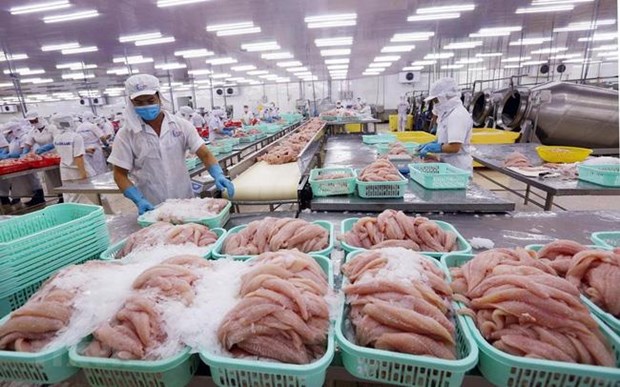Agro-forestry-fishery exports generate 23.03 billion USD in seven months
The agro-forestry-fishery sector raked in 3.55 billion USD from exports in July, raising the total value in the first seven months of this year to 23.03 billion USD, up 2 percent year on year, the Ministry of Agriculture and Rural Development has reported.
 Tra fish processed for export (Photo: VNA)
Tra fish processed for export (Photo: VNA)Hanoi (VNA) – The agro-forestry-fishery sector raked in 3.55 billion USD from exports in July, raising the total value in the first seven months of this year to 23.03 billion USD, up 2 percent year on year, the Ministry of Agriculture and Rural Development has reported.
Major farm produce shipped overseas brought home 10.84 billion USD, with five “billion dollar” good categories being coffee (1.8 billion USD), rubber (1.1 billion USD), rice (1.73 billion USD), cashew (nearly 1.8 billion USD), and vegetables and fruits (2.3 billion USD).
The ministry said export revenue of agricultural products fell 8.2 percent year-on-year, and this was due to a drop in several products like cashew (20.6 percent), pepper (25.2 percent), coffee (12 percent), and rice (16 percent).
The export prices of two main seafood exports, tra fish and shrimp, dropped 3.2 percent and 10.4 percent to 1.16 billion USD and 1.73 billion USD, respectively, causing seafood export revenue dwindle 1 percent to 4.68 billion USD.
During January-July, shipments of main forestry products earned the country nearly 6.01 billion USD, up 17.3 percent year on year, of which wood and wooden products contributed over 5.6 billion USD, up 16.1 percent, and bamboo and rattan products 264 million USD, soaring 46.6 percent.
According to the ministry, Vietnam spent 18 billion USD on foreign agro-forestry-fishery goods and agricultural materials.
As global economic growth is projected to fall while agricultural development will bounce back in many countries, it will be hard for Vietnam’s agricultural exports in the coming time, the ministry said.
Fierce competition will pull prices of exports down. Besides, large importers of Vietnam like the US, the EU, China, Japan and the Republic of Korea have imposed strict standards on quality management, food safety and hygiene, and origin traceability on agricultural imports.
The ministry will work with businesses and associations to keep a close watch on the development of the markets, as well as enhance inspection on smuggling in the domestic market.
Besides coordinating with competent ministries and sectors to stabilise traditional markets and expand potential ones, helping reduce dependence on single country, the ministry will give production guidance to localities to ensure that their products meet importers’ requirements on origin traceability and geographical indication.
Furthermore, due attention will be given to developing brands for agricultural products, particularly those exported to the Chinese market, while relevant authorities will set up coordination mechanism with the Chinese General Administration of Customs so as to remove bottlenecks in the trading of agricultural products between the two countries.-VNA













